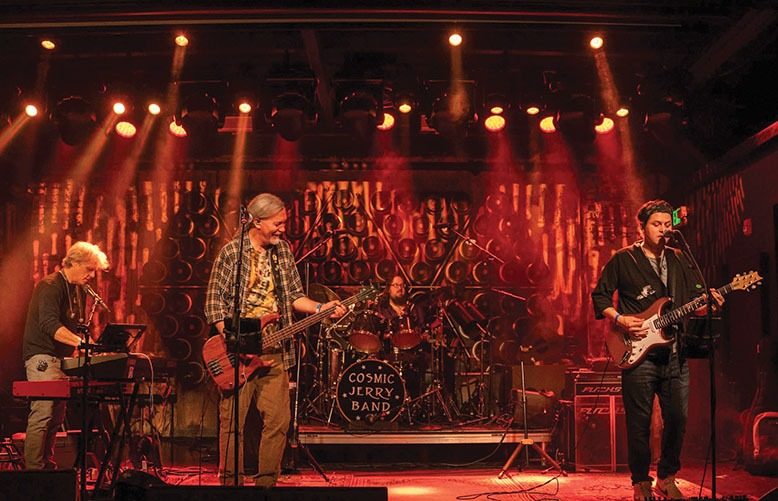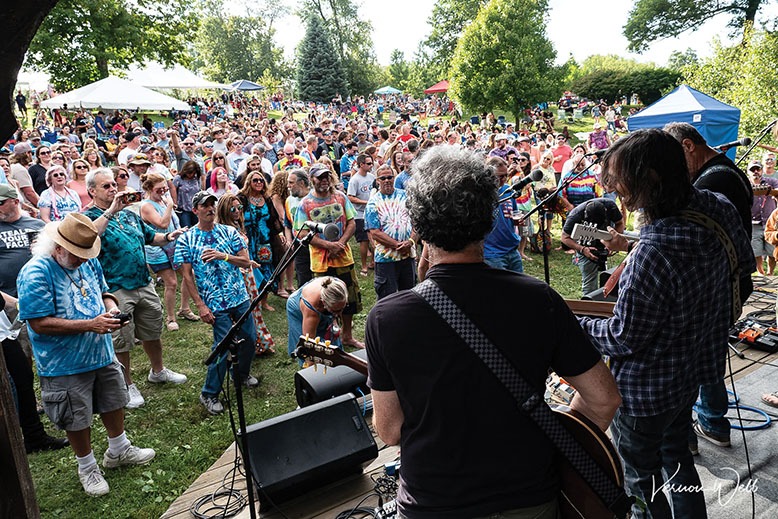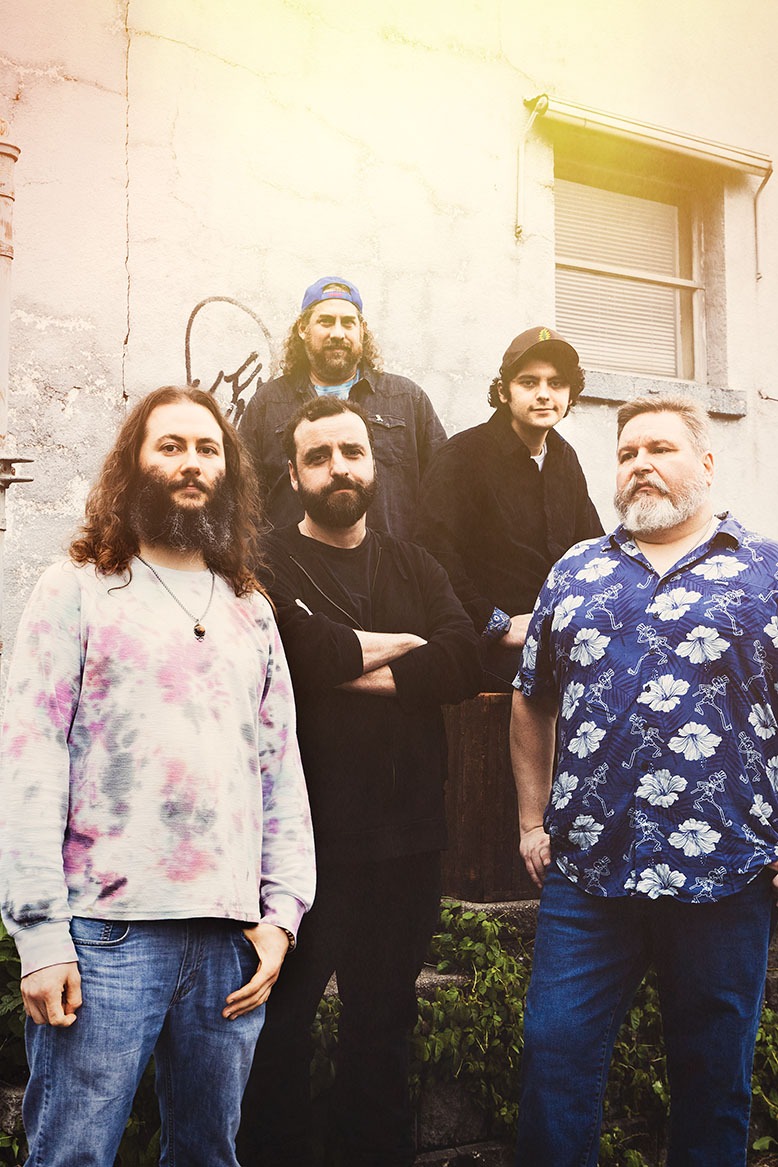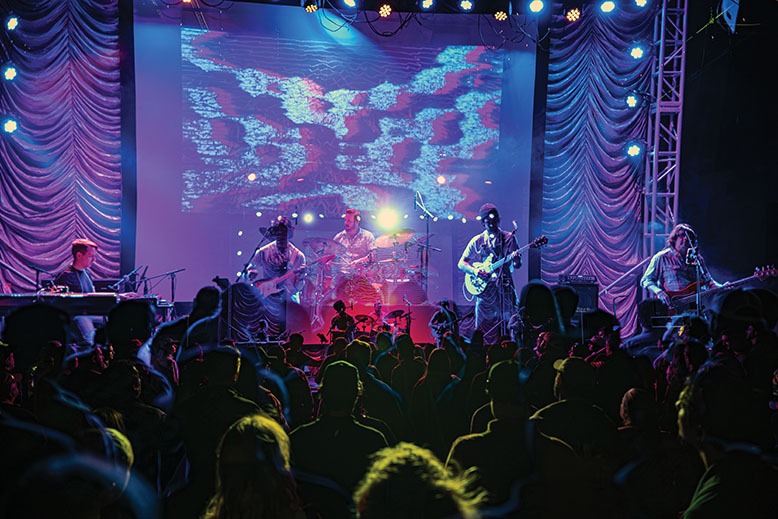
The music of the Grateful Dead endures and, indeed, prospers nearly 30 years after the death of Jerry Garcia. Surviving members Bob Weir, Mickey Hart and Bill Kreutzmann (along with jam-band superstar John Mayer) regularly sell out arenas as Dead & Company, and even 84-year-old Phil Lesh still performs in front of packed houses on ocassion. But the music truly lives and breathes on stages large and small through a national underground of Grateful Dead tribute bands, and in that scene, New Jersey is ground zero.
There are the Cosmic Jerry Band from Asbury Park; American Beauty Band of New Brunswick; the Englishtown Project, named after a legendary 1977 concert at Raceway Park in Englishtown; and Reflections from North Jersey. The national database gratefuldeadtributebands.com lists more than 40 Dead tribute bands in the Garden State. While non-fans may be quick to brush off Deadheads as weed-loving hippies stuck in another era, music-industry experts, musicians and true fans tell a far different story of why this cover-band scene flourishes with timeless songs that bond a unique community of followers.

Englishtown Project is named after a legendary Grateful Dead show in 1977 at Raceway Park in Englishtown. Photo: Vernon Webb
“It’s a really fascinating way that this culture is perpetuating itself,” says Jesse Jarnow, an author and the cohost of the podcast Good Ol’ Grateful Deadcast. “Dead music is alive in a way that’s different from going to fan conventions or something. It’s still an active conversation.”
Mike Manuele, who organizes a regular Tuesday Grateful Dead night at the Orange Lantern in Paramus, has 40 bands on his roster. As a bassist who plays in several Dead cover bands himself and often sits in with groups at the Lantern, Manuele sees a surprising depth in the scene.
At the Lantern, he makes an effort to “mix it up” in his lineup, both geographically and stylistically. “I try to get bands who do different things, like acoustic bands or young groups,” Manuele says. “So it doesn’t all sound the same, and it’s not just the same bands we’re used to seeing in this area.”

Katie Giordano of American Beauty Band at the Orange Lantern in Paramus. Photo: Vernon Webb
Manuele echoes other Deadheads in his admiration for the community the music engenders. “We call it a family, and the Grateful Dead is just one of those things—it’s an amazing phenomenon,” he enthuses. “It’s a lot of super, wonderful people, and, no pun intended, but I’m very grateful for what it’s meant to me and what it’s done to my life. And for me, what I’m doing on Tuesdays is one small way of giving back to this great thing that’s done so many positive things for me and many other people.”
You’ll find an unlikely convert to Jersey’s Dead tribute-band scene in David Krumholtz, an actor with impressive and memorable credits in television, film and theater including CBS’s Numb3rs, the 2023 hit Oppenheimer, the holiday classic The Santa Clause, and the acclaimed 2022 Broadway show Leopoldstadt. Krumholtz, who was born and raised in New York City, spent 15 years in Los Angeles before deciding to move to Bergen County about a decade ago to raise his family.
“The culture shock was enormous—I had never really lived in suburbia before, and I started to go a bit stir-crazy,” Krumholtz says. “So what does one do when one’s bored? You hit the Facebook events page. And it was glaringly obvious that there was a robust live-music scene going around me in Bergen County, and half of it, or at least a large portion, was Grateful Dead cover bands.” Krumholtz says he “wasn’t a huge fan, but I did like some of their songs, so I thought it might be interesting.”
“And the truth is, I’m a working actor, and I spend half my time working on getting work and waiting for the phone to ring. So I started going out.”
Krumholtz’s odyssey from professional actor to part-time musician began one quiet night while watching Touch of Grey, one of the area’s better-known Dead tribute acts. “One night, they were having a rough night, not a lot of people, and I started singing along with them under my breath, and the singer’s girlfriend came over and got me to get on stage and sing a few songs with them,” Krumholtz recalls. “That was awkward, but we’re talking about 1 am in a dive bar just singing a bunch of Grateful Dead tunes randomly to basically no one.”
Krumholtz found himself hooked and became a fixture at Touch of Grey shows. “I’ve been doing it ever since,” he says. “I ended up leaving Touch of Grey and joining another band called One Man Gathers, or OMG. And then, recently, I started my own band called Her Angels in Flame, which is a combination of members from other popular bands.”

Her Angels in Flame members, from left: Jon Chazen, David Krumholtz, Josh Kates, Christopher Hanson and Eric Cohen. Not pictured: Paul Kates. Photo: Justin Borucki
The name Her Angels in Flame comes from the lyrics of the Dead’s “Help on the Way.” Krumholtz still sits by the phone waiting for that next acting gig, but his passion for the band and scene is inspiring.
“What ended up happening is I made a bunch of amazing friends, not just in the band or in the other bands that I was going to see, but the Deadhead scene itself,” he says. “In New Jersey, or at least in Bergen County, it’s a very close-knit family, and there’s a kinship there.”
Josh Kates, who is one of Krumholtz’s bandmates in Her Angels in Flame and is also active in several other Dead-related projects, including Touch of Grey, Reflections and DeadiKates, says there is a “huge community” with “a lot of familiar faces night after night” listening to their music. “The songs have become anthems from the Great American Songbook at this point,” Kates says.

Her Angels in Flame Photo: Justin Borucki
While the popularity of the Dead tribute-band scene may come as no surprise to anyone who makes the rounds at area music venues (or scans Facebook,) it’s not widely known that the phenomenon actually began right here in Bergen County, New Jersey. John Zias, now 71 years old and a musician in Florida, lays claim that his band, Cavalry, was the first to cover the Grateful Dead on stage.
Zias discovered the first Dead album as a Bergen County tween in 1967. ”A guy in a subway station was holding it and it just caught my eye,” he remembers. “I knew this kid who had bought it, and I borrowed it from him and never gave it back.”
Soon, Zias was lying to his parents and sneaking into New York City for concerts. Two weeks after his 15th birthday, he went to see the Jefferson Airplane open for the Grateful Dead in Central Park. “I was like, Why are the Airplane opening for the Dead?” he recalls. “The Airplane killed, but then half an hour later, the Dead come on, looking completely outside of anyone’s box. Like pirates. And they started playing, and, literally, you could hear the concrete under you shaking. It was one of the loudest, most powerful, most exotic sounds I had ever heard.”
Zias says it changed his life. “This show proved to me that that there was something extra there, at that age where you’re discovering how far you can reach in terms of grasping concepts and levels of consciousness….I know I’m getting cosmic here, but that’s how the Dead appealed to a certain personality type and how they’ve been able to transcend generations,” he says. “Even back then, you’d be at a show sitting next to a 17-year-old kid and then someone who’s 77.”
Zias started dabbling with playing the Dead’s music in 1968 with his friend Kenny White (who went on to have a long career as a studio musician). “We were doing it in our bedrooms, just guitar and keyboards, and learning whatever was on the first two albums,” Zias says. “The third album came out in 1969, and we started learning all the songs, and by September of ’69, we put a band together.”
Soon, Cavalry was playing a solid number of shows, sometimes with another local group called Cheyenne, which took its inspiration from the band Quicksilver Messenger Service, playing some of their covers plus their own original tunes.
“We had a scene of budding hippies, about a 100 people who’d come to see us,” Zias remembers. “We were turning scores of people on to the Grateful Dead.”
Eventually, New Jersey became one the Grateful Dead’s busiest markets, but it didn’t happen right away. In 1977, Dead fever was in full swing in New Jersey with the band’s record-breaking show at Raceway Park in Englishtown. With 107,000 fans rocking out, it is considered the largest ticketed concert in U.S. history. This summer, Dark Star Orchestra, a popular Dead tribute band, is recreating that show at the Stone Pony Summer Stage in Asbury Park, just 25 miles from Englishtown.
[RELATED: Stone Pony Celebrating 50 Years in Asbury Park]
“Until Workingman’s Dead and American Beauty came out, there was very little interest in the Dead,” notes Zias of the albums released in 1970. “We created this enthusiasm thing, and who woulda thunk that 55 years later, we’d still be talking about it?”
An important part of the early conversation surrounding the Dead happened thanks to Relix, which began as a Grateful Dead newsletter that was sold in parking lots before shows to help tape traders connect and later morphed into a respected music publication focusing on live and improvisational music.
As the editor of Relix for over a decade, Josh Baron developed his own perspective on the Grateful Dead’s allure.
“The enduring draw of Dead cover bands comes down to the strength of the music itself and how powerful the songs are, and this may sound a little hippie-dippie-ish, but how they catalyze the ability of people to hang out together and experience music together,” Baron says.
The element of improvisation is also key to the fan experience. “Generally, they’re thought of as cover bands, but the music they’re playing is structured in a way that allows for improvisation,” says Baron. “So just as no two Grateful Dead concerts were ever the same, no two Grateful Dead cover-band concerts are ever going to be the same because there’s such an element of improvisation to it.”
“I think that’s what engages the crowd,” Baron continues, “versus, say, a typical cover band where the band focuses on the hits, and it’s like the same 10 songs every night, and they’re gonna play those songs and that’s it.”
Baron also emphasizes that Dead cover bands don’t just cover songs written by the Grateful Dead, just like the Grateful Dead didn’t only play songs written by the Grateful Dead. “The Dead in their own right were something of a cover band, and a number of their songs were not their own but became a standard part of the repertoire,” Baron says.
The number of Dead tribute bands is only growing, in New Jersey and elsewhere. “There’s probably no other rock band in the world that has as many tribute bands as the Grateful Dead,” says Jay Blakesberg, who has photographed the national rock scene since 1978 and whose portfolio includes many famous images of the Dead. “Every state, everywhere you go in this country, you can probably find a Grateful Dead cover band any night of the week anywhere you go. Many of these groups have become nationally famous touring bands, while some are micro-regional.”
Take Strangers Stopping Strangers, a Dead tribute band based in urban Hudson County. The group formed when musician Jeff Greenspan relocated to Hoboken from Maryland and approached James Calleo, an established Jersey City singer/songwriter and bandleader playing Americana and alt-folk.
“We met at open mics and stuff, and Jeff wanted to start a Grateful Dead cover band,” Calleo recalls.
Strangers Stopping Strangers had just started to make itself felt on the local scene when the pandemic closed everything down. “That’s when we started doing virtual videos and actually learning how to play the songs well enough for it to sound halfway decent,” Calleo says.
After the pandemic, the band hit the road running, and a show at Jersey City’s popular White Eagle Hall solidified its following.

Strangers Stopping Strangers performs at the Williams Center in Rutherford earlier this year. Photo: Courtesy of Taylor Weinberg
For Calleo, covering the Grateful Dead offers a channel to creativity. “We just decided to pull stuff from our own influences,” he says. “We learned the music as far as structure and key riffs, but we’re not trying to mimic the Dead whatsoever.” He adds, “So what we do is take the songs as a framework and then just allow them to go wherever. Once we learned about 100 songs, we actually stopped rehearsing. We decided that it would take away the threat live. A lot of what appeals to this audience is a sense of communal creativity; you’re watching something being created onstage.”
“What makes it fun and sustainable mentally for us is to watch all these people move and start dancing. We get up there with no plan, no baggage beyond a set list, and if a jam is happening for five minutes and feels like it’s going stale, we just stop. But if it seems like everyone’s really diggin’ it, you just kind of look at each other and laugh and keep going with it. I call it a vacation onstage where there’s really nothing to worry about whatsoever.”
As longtime fans will tell you, it’s hard to stay away from the scene, even if you try. Zias, who is credited as starting the Grateful Dead tribute-band phenomenon with Cavalry back in the late 1960s, decided to walk away at the age of 22 to create his own music. But he returned to the Dead later in life.
Today, he plays in his own Dead cover band, Unlimited Devotion, often sits in with Tampa’s Uncle John’s Band, and also plays originals in the Joint Chiefs.
“Dead music hits a lot of different levels of emotion and human consciousness,” Zias says of the enduring popularity. “There’s a Dead for everybody. There’s ‘Sugar Magnolia’ for the pop kids, there’s ‘Dark Star’ for the yobs who took a lot of LSD in their youth like me. There’s stuff that rocks you out of your seat. They created a conglomeration of music that draws from everywhere, but always has a touch of wisdom behind it, even when they’re playing what would be considered today some really chill stuff.”
“There’s always a third-eye element to Grateful Dead music at its best. Everybody gets something that’s elevating. That music taps into something completely unconsciously that is the most enduring phenomenon that I’ve ever experienced in my 71 years, and it will keep going.”
Jim Testa is an award-winning music columnist for the Jersey Journal/NJ.com and editor/publisher of the long-lived JerseyBeat.com.
No one knows New Jersey like we do. Sign up for one of our free newsletters here. Want a print magazine mailed to you? Purchase an issue from our online store.



